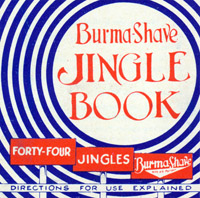|
Burma-Shave was sold in both jars and tubes, shown here in this early 1940s packaging. ID.THF65330 |
| |
 |
| Burma-Shave Jingle Book, 1936. ID.THF 65105 |
|
The Burma Vita Company was a small, family-owned firm based in Minneapolis, Minnesota. One of their products was Burma-Shave, the first brushless shaving cream -- which they touted as a modern, time-saving marvel. The product’s mythical origin-story related that an American sailor stationed in Burma discovered the recipe and provided it to the company's founders -- who saw the potential in a product that did away with the brush and mug, allowing men the convenience of simply patting the cream onto their skin.
In 1925, the Burma Vita Company began producing their innovative roadside advertising signs to promote this product. Each series of signs contained rhyming lyrics, always ending with the words "Burma-Shave." These signs were placed where motorists would see them in a staggered sequence, usually along a rural, monotonous stretch of highway on frontage leased from farmers and other property owners. By the mid 1930s, signs stretched from coast to coast. Only Arizona and Massachusetts lacked representation.
The public saw the signs whenever they traveled long distances and their impact was remarkable. The geographic breadth in their placement gave rise to the notion that Burma-Shave was a product of a large conglomerate. The humor and folksiness of their jingles resonated with a Depression-weary audience, leading the public to view them as more than simply advertising. They became a form of popular entertainment. This approach was so successful that, by 1936, Burma-Shave became the number two selling shaving cream in America -- an amazing feat for a small, family-owned Midwestern company.
In 1936, eleven years after the first signs appeared, the company produced a souvenir Jingle Book, acknowledging the intense public interest in the signs. Along with the Jingle Book, the Burma Vita Company included a sample set of razor blades.
Burma-Shave remained successful until the late 1950s. But its advertising campaign relied almost solely on passing motorists for its success. With the development of the interstate highway system, motorists began driving faster. Consequently, advertising signs became larger and were placed farther away from the road -- making the relatively small Burma-Shave signs less conspicuous to passing vehicles. Sales plummeted and the Burma-Shave signs started to come down. By the end of 1966, the line was discontinued.
How did The Henry Ford acquire our set of signs? In 1965, as production at the company was winding down, the proprietors recognized the historic value of the signs and fabricated two sets with a jingle dating to 1933. One set was offered to The Henry Ford and the other to the Smithsonian Institution’s National Museum of American History, in Washington, D.C.
These nostalgic Burma-Shave signs are the quintessential reminders of an era when Americans began to travel long distances by automobile -- and advertising’s notable response to technological and cultural change.
| |
-- Charles Sable, Curator of Decorative Arts |
|

